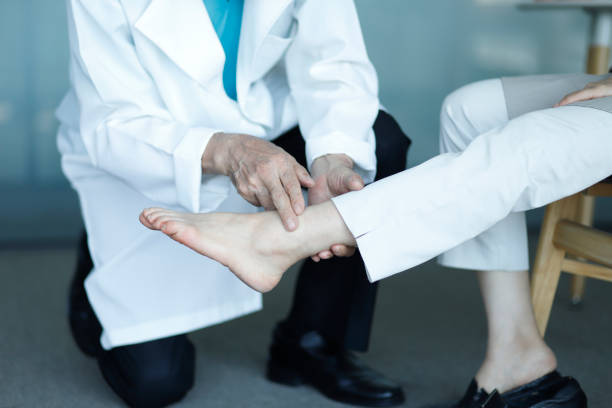Understanding Ankle Pain: Causes and Treatment Options
Ankle pain can be a hindrance to the smooth functioning of our daily lives, affecting our ability to walk, run, or participate in sports. Despite its common occurrence, the causes of ankle pain can be incredibly varied, making it essential for individuals to understand the reasons behind their discomfort and the options available for its treatment. This comprehensive guide will walk you through the intricacies of ankle pain, from its roots to potential remedies, offering a supportive hand
Introduction to Ankle Pain: Its Prevalence and Impact on Daily Life
Ankle pain is a prevalent issue that affects individuals across various age groups and lifestyles. It is estimated that a significant portion of the population will encounter some form of ankle discomfort in their lifetime due to the ankle’s intricate structure that bears the body’s weight. This vulnerability makes the ankle prone to injury and strain during everyday activities like walking or climbing stairs, as well as during more physically demanding tasks such as sports.
The consequences of ankle pain extend beyond the physical realm, impacting one’s quality of life. Those experiencing ankle pain may face restrictions in mobility, hindering their ability to partake in regular exercise or enjoy hobbies they once cherished. Recognizing the common occurrence and potential repercussions of ankle pain is crucial for taking the initial step in addressing the issue and seeking appropriate treatment options.

Ankle Pain
A Step-By-Step Look at Ankle Pain: Common Causes and Identification
Ankle pain can stem from various sources, ranging from acute injuries to chronic conditions. Identifying the cause of ankle pain is a critical first step in finding effective treatment options. Here are some of the most common causes:
- Sprains and Strains: These are the most frequent causes of ankle pain, occurring when the ligaments that support the ankle stretch beyond their limits or tear. Sprains and strains are common among athletes and can result from a sudden twist or impact.
- Fractures: An ankle fracture involves a break in one or more of the bones that make up the ankle joint – primarily the tibia, fibula, or talus. Symptoms often include immediate and severe pain, swelling, and difficulty bearing weight on the affected ankle.
- Tendonitis: This condition is caused by the inflammation of the tendons, which are the thick cords that attach muscles to bones. Tendonitis in the ankle often results from overuse or improper use, leading to pain and swelling.
- Arthritis: Several forms of arthritis can affect the ankle, including osteoarthritis, rheumatoid arthritis, and gout. Arthritis leads to joint inflammation, resulting in pain, stiffness, and swelling.
- Gout: Specifically affecting the joint at the base of the big toe, gout can occasionally affect the ankles as well. It is characterized by sudden, severe attacks of pain and swelling caused by a buildup of uric acid.
Identifying the cause of ankle pain typically involves a detailed medical history and physical examination. Healthcare providers may also request imaging tests such as X-rays, MRIs, or CT scans to accurately diagnose the issue and plan effective treatment strategies. Early diagnosis and treatment are crucial in preventing further damage and ensuring a successful recovery.
Conservative Treatment Options for Ankle Pain
For many individuals experiencing ankle pain, there are various conservative treatment options available that do not require surgery. These methods can significantly alleviate pain, reduce inflammation, and improve ankle function. Here are some commonly recommended conservative treatments for ankle pain:
- Rest: One of the most crucial steps in treating ankle pain is allowing the ankle to rest. Avoid activities that put excessive stress on the ankle, such as running, jumping, or prolonged standing.
- Ice: Applying ice to the affected area can help reduce swelling and alleviate pain. It’s advisable to ice your ankle for 20 minutes at a time, several times a day, especially in the first 48 to 72 hours after experiencing pain.
- Compression: Using an elastic bandage or compression wrap can provide support and decrease swelling. Be careful not to wrap the bandage too tightly, as this can hinder circulation.
- Elevation: Keeping the ankle raised above heart level whenever possible can help reduce swelling by allowing fluids to drain away from the area.
- Physical Therapy: A physical therapist can develop a personalized exercise program to strengthen the ankle, improve flexibility, and increase range of motion. These exercises can also help prevent future injuries.
- Nonsteroidal Anti-Inflammatory Drugs (NSAIDs): Over-the-counter medications such as ibuprofen and naproxen can relieve pain and reduce inflammation. It’s important to use these medications as directed and consult with a healthcare provider for prolonged use.
- Orthotic Devices: For some, using orthotic devices like braces or special footwear can offer additional support and stability to the ankle, reducing pain during activity.
Each individual’s case of ankle pain is unique, and what works for one person may not be effective for another. Therefore, it’s essential to work closely with healthcare professionals to identify the most appropriate conservative treatment approaches for your specific situation. In cases where conservative treatments do not provide sufficient relief, more advanced options like surgery may be considered. However, many find significant improvement with these non-invasive methods, often avoiding the need for surgical intervention.
Advanced Treatment Methods for Chronic Ankle Pain
When conservative treatments fail to alleviate chronic ankle pain, advanced treatment methods may be considered to restore mobility and reduce discomfort. These options often involve more invasive procedures but can offer long-term relief for those suffering from persistent ankle issues. Below are some advanced treatment methods for chronic ankle pain:

Ankle Pain
- Corticosteroid Injections: For severe inflammation and pain, corticosteroid injections directly into the ankle joint can provide temporary relief. These are generally used for cases where swelling significantly impairs mobility and quality of life.
- Ankle Arthroscopy: This minimally invasive surgery involves inserting a tiny camera into the ankle joint to diagnose and sometimes treat issues within the joint. It can be used to remove loose bone fragments, repair damaged tissue, or evaluate arthritis severity.
- Ligament Reconstruction: In cases where ankle instability is due to torn or stretched ligaments, ligament reconstruction surgery may be necessary. The surgeon will repair the damaged ligaments, often using a graft from another tendon in the body.
- Ankle Fusion (Arthrodesis): For severe arthritis or when other treatments have failed, ankle fusion may be an option. This procedure involves removing the surfaces of the ankle joint and joining the bones together so they heal into one solid unit, thereby eliminating joint pain. However, it also limits ankle mobility.
- Total Ankle Replacement (Arthroplasty): In this procedure, the damaged ankle joint is replaced with an artificial joint. While preserving more ankle motion than fusion, it is typically recommended for older, less active individuals or those with advanced arthritis.
It’s crucial to consult with a healthcare provider to thoroughly discuss the benefits and risks associated with each advanced treatment option. The choice of treatment depends on various factors, including the cause of ankle pain, the patient’s overall health, and their lifestyle. In some cases, a combination of treatments may offer the best path to pain relief and improved ankle function. Post-procedure rehabilitation will be necessary to strengthen the ankle and restore as much function as possible.
Preventing Ankle Pain Through Strengthening and Prevention
Preventing ankle pain is essential for maintaining mobility and enjoying a high quality of life. Strengthening and preventive measures can play a significant role in avoiding injuries that lead to chronic ankle issues. Here are several strategies to consider for enhancing ankle strength and preventing pain:
- Regular Exercise: Engaging in exercises that focus on strengthening the muscles around the ankle can improve stability and reduce the risk of injuries. Activities like toe raises, heel walks, and resistance band exercises can be particularly beneficial.
- Proper Footwear: Choosing the right shoes for different activities can significantly impact ankle health. Shoes should provide ample support, cushioning, and fit well to minimize undue strain on the ankles.
- Balance Training: Incorporating balance exercises into your routine can help improve proprioception (sense of body position), which is crucial for preventing ankle sprains and strains. Simple exercises such as standing on one foot or using a balance board can be effective.
- Flexibility Exercises: Maintaining good flexibility in the ankle and surrounding muscles through stretching can prevent stiffness and reduce the risk of injuries.
- Avoid Overuse: Listening to your body and avoiding overexertion is key. Ensure adequate rest and recovery time between intense activities to prevent overuse injuries.
- Warm-Up and Cool-Down: Properly warming up before and cooling down after physical activity can prepare the muscles and joints for exercise and reduce the likelihood of ankle pain.
- Nutrition and Hydration: Keeping the body well-nourished and hydrated supports overall health and can aid in the prevention of injuries.
By incorporating these strategies into your daily routine, you can significantly reduce the risk of experiencing ankle pain and promote overall ankle health. Remember, consistency is crucial – taking preventive measures regularly is the best way to protect your ankles and maintain your active lifestyle.
Identifying When to Seek Professional Help
While many instances of ankle pain can be managed with home care and conservative treatments, there are certain situations where seeking professional help becomes essential. Understanding when to consult a healthcare provider can help prevent further injury and ensure appropriate treatment. Here are key indicators that it’s time to seek professional help for ankle pain:
- Persistent Pain: If your ankle pain lasts longer than a few weeks despite home care and rest, it’s a sign that professional evaluation is needed.
- Severe Pain or Swelling: Sudden, intense pain or swelling that doesn’t improve with rest and ice may indicate a serious injury, such as a fracture or severe ligament damage.
- Inability to Bear Weight: Difficulty walking or bearing weight on the affected ankle without significant pain could signal a more serious condition requiring medical attention.
- Deformity: Any visible deformity in the ankle, such as a dislocation or abnormal angle, needs immediate medical evaluation.
- Signs of Infection: Redness, warmth, fever, or a feeling of heat around the ankle could indicate an infection, which requires prompt treatment.
- Lack of Improvement: If conservative treatments such as rest, ice, and over-the-counter pain relievers do not alleviate the pain or if the condition worsens, professional assessment is advisable.
- Recurrent Pain: Experiencing repeated episodes of ankle pain or instability, especially during certain activities or movements, suggests underlying issues that may need more specialized care.
In such cases, a healthcare provider can perform a thorough evaluation, including physical examinations and imaging tests like X-rays or MRIs, to diagnose the cause of your ankle pain accurately. Treatment plans can then be tailored specifically to your needs, potentially including referrals to specialists such as orthopedists or physical therapists. Taking the step to seek professional help when these signs are present can be crucial in achieving a full recovery and preventing long-term damage to the ankle.

Ankle Pain
Understanding the Role of Physical Therapy in Ankle Pain Management
Physical therapy plays a pivotal role in managing and alleviating ankle pain, serving as a crucial component of both recovery and prevention strategies. Through targeted exercises and personalized treatment plans, physical therapists can help patients regain strength, flexibility, and range of motion, significantly aiding the healing process. Furthermore, physical therapy emphasizes educating patients on proper movement mechanics and injury prevention techniques, equipping them with the knowledge to minimize future ankle issues.
An integral aspect of physical therapy involves assessing the patient’s specific condition to tailor exercises that target weakened or injured areas. These exercises often focus on improving proprioception, enhancing balance, and restoring normal ankle function. Therapists also employ manual therapy techniques, such as massage and joint mobilization, to reduce pain and inflammation, thereby accelerating the recovery process.
In addition to rehabilitation post-injury, physical therapy can be employed proactively to prevent ankle injuries. By strengthening the muscles surrounding the ankle and improving flexibility, individuals can better withstand the stresses of daily activities and sports, reducing their risk of sprains, strains, and other ankle-related issues. Adopting a routine of physical therapy exercises as part of a comprehensive approach to ankle care can significantly contribute to long-term ankle health and mobility.
Overall, ankle pain prevention involves being proactive and implementing healthy habits that support the optimal functioning of the ankle. Incorporating proper warm-up, balance training, flexibility exercises, and rest into your routine can significantly reduce the risk of injuries. However, if you experience persistent or severe ankle pain, seeking professional help is crucial for accurate diagnosis and appropriate treatment. Physical therapy plays an essential role in managing ankle pain and preventing future issues, making it a valuable tool for maintaining an active lifestyle. Remember, taking care of your ankles today means better mobility and function tomorrow.
Flagstaff Foot Doctors: Anthony Rosales DPM
https://www.google.com/maps?cid=8835841318590452161
421 N Humphreys St, Flagstaff, AZ 86001, United States
(928) 774-4825
https://flagstafffootandankle.com/
